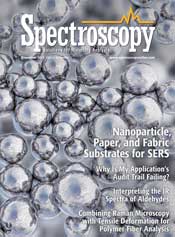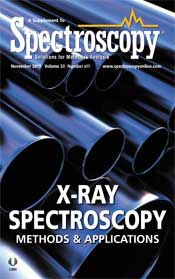In our November issue:
COLUMNS
Molecular Spectroscopy Workbench
Raman Microscopy Combined with Tensile Deformation for Understanding Changes in Polymer Morphology
Fran Adar
We show Raman spectra of polymeric fibers acquired as a function of increasing stress and temperature. With knowledge of Raman band assignments, it becomes possible to understand, in detail, the molecular changes that are responsible for polymer orientation and crystallization.
Read more »
|
ADVERTISEMENT
A-TEEM Molecular Fingerprinting: A New and Exciting Spectroscopy Technique
On Demand
 Learn more Learn more |
Focus on Quality
Why Is My Application's Audit Trail Rubbish?
R.D. McDowall
It has been 20 years since 21 CFR 11 came into effect. And with increased emphasis on data integrity, an audit trail is essential for spectroscopy software. Why then do many audit trails fail to meet regulatory requirements?
Read more »
|
IR Spectral Interpretation Workshop
The C=O Bond, Part II: Aldehydes
Brian C. Smith
Aldehydes feature a unique "lone hydrogen" atom, giving rise to unique C-H stretching and bending peaks, making them easy to spot. In this installment, a new feature is also presented, "IR Spectral Interpretation Review," where key concepts from past columns are presented for those new to the column and for readers who need a refresher.
Read more »
|
Peer-Reviewed Article
Surface-Enhanced Raman Spectroscopy: From Concept to Practical Application
In the last decade, numerous SERS substrates have been developed, but it is difficult to compare and validate their plasmonic performance. In this overview, the authors discuss the three physical parameters of any new SERS platform that must be measured—morphological characterization, optical scattering (far-field response), and near-field properties—and future prospects for the development of new SERS platforms.
Read more » |
X-ray Spectroscopy Methods & Applications
Advances in Stress Measurement with Portable X-Ray Diffraction: Uncertainties in Normal and Shear Stress Determination on Mild Steel Pipe
Seung-Yub Lee, Jingjing Ling, and Adrian Chitu
To test the accuracy of residual stress measurements made with portable X-ray devices, measured normal and shear stresses were compared with the applied (true) values for accuracy assessment. From those results, practical measurement and analysis protocols for precise and accurate stress measurements are proposed.
Read more »
Recent Developments in Small-Angle X-Ray Scattering
N. Sanjeeva Murthy
There has been a resurgence in the application of small-angle X-ray scattering for a large range of problems in materials science. This article highlights experimental requirements and applications, with examples drawn from protein solutions, porous structures, and polymers.
Read more »
EDXRF Analysis of Sulfur and Trace Element Content in FAMEs
Dirk Wissmann
The EDXRF method described here is a quick and economical procedure to check samples for their oxygen content to ensure that the material used for diesel fuel blending is really FAME-based and not mineral-oil based.
Read more »
In Vivo XRF Analysis of Toxic Elements
Interview with David R. Chettle
David R. Chettle, a professor at McMaster University in Hamilton, Ontario, Canada, uses X-ray fluorescence spectroscopy for the in vivo measurement of toxic elements in human subjects, with the goal of developing devices that can be used to investigate the possible health effects of toxin exposure. He recently spoke to us about his research.
Read more »
|
|
 |
Download the
issues: |
 |
 |
 |
 |
 |
 |
| |
| UPCOMING WEBCAST |
Why and When to Couple IC with ICP-MS for Speciation Analysis
Wednesday, November 15, 2017, 11 am EDT
Sign Up Here » |
| ON DEMAND WEBCASTS |
A-TEEM™ Molecular Fingerprinting: A New and Exciting Spectroscopy Technique
Sign Up Here » |
Improving Extractables and Leachables and Trace Metal Testing of Pharmaceutical Packaging
Sign Up Here » |
Understanding the Advantages of Microwave Extraction Technology for Environmental Laboratories
Sign Up Here » |
How to Maximize Your ICP-MS Performance
Sign Up Here » |
Single Particle Mode or Hyphenated ICP-MS? A Discussion of Nanoparticle Analysis in Complex Matrices
Sign Up Here » |
|
If you would like to submit an article to Spectroscopy, contact Laura Bush, Editorial Director - Laura.Bush@ubm.com
Spectroscopy is free to qualified subscribers. To subscribe, click here.
Click here to contact the Spectroscopy sales team. |


